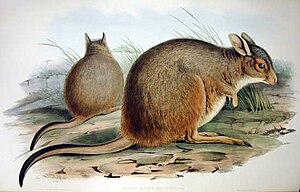Shaggy rabbit kangaroo
| Shaggy rabbit kangaroo | ||||||||||||
|---|---|---|---|---|---|---|---|---|---|---|---|---|

Shaggy rabbit kangaroo ( Lagorchestes hirsutus ), |
||||||||||||
| Systematics | ||||||||||||
|
||||||||||||
| Scientific name | ||||||||||||
| Lagorchestes hirsutus | ||||||||||||
| Gould , 1844 |
The shaggy rabbit kangaroo ( Lagorchestes hirsutus ), also called mala , is a species of marsupial from the kangaroo family (Macropodidae).
features
Shaggy rabbit kangaroos are among the smallest kangaroos: they reach a head body length of 31 to 39 centimeters, a tail length of 25 to 38 centimeters and a weight of 0.8 to 1.7 kilograms. Their dense fur is colored gray-brown on the upper side, the underside is lighter. The name-giving feature is the long, red-brown hair on the back. As with most kangaroos, the back legs are significantly longer than the front legs. The head is relatively small, but the ears are long.
Distribution and way of life
The original range of the shaggy rabbit kangaroo comprised around 25 percent of Australia , so they lived in the Northern Territory , Western Australia and northwestern South Australia . Today they no longer occur on the Australian mainland, the only stocks live on the Bernier and Dorre Islands off the coast of Western Australia. Their original habitat is dry grasslands overgrown with prickly head grass.
Shaggy rabbit kangaroos are nocturnal animals that sleep in earthen burrows during the day. At dusk they come out of their hiding places and start eating. They live solitary and usually avoid contact with conspecifics. Their diet consists of grasses, herbs and seeds, and sometimes fruits. Like all kangaroos, they have a multi-chambered stomach in order to be able to better utilize the difficult to digest plant food.
Danger
With the colonization of Australia by the Europeans, the population of the shaggy bunny kangaroos began to decline. The reasons for this lie in the changes in the habitat: the practice of the Aborigines , annually to cultivate smaller areas by slash and burn, ensured sufficient cover and food thanks to the different growth phases of the plants. With the expulsion of the Aborigines this practice was discontinued, instead there were more frequent huge bush fires that decimated the population. Further reasons for the decline are the food competition from the introduced rabbits and the stalking by the also introduced foxes .
In the 1990s, the last stocks on the mainland disappeared, and a population in the Tanami Desert was wiped out by a bush fire . Since then, only the stocks on Bernier and Dorre Island have survived in the wild. Some animals are bred in captivity, and a release program took place on Trimouille Island off the northwest coast of Australia. Around 120 animals now live on Trimouille Island, the population size on Bernier and Dorre Island is not known, estimates from the 1990s amount to 4300 to 6700 animals. The IUCN lists the species as "endangered" ( vulnerable ).
literature
- Ronald M. Nowak: Walker's Mammals of the World. 6th edition. Johns Hopkins University Press, Baltimore 1999, ISBN 0-8018-5789-9 .
Web links
- Information, photos and videos at arkive.org
- Lagorchestes hirsutus onthe IUCN Red List of Threatened Species . Retrieved May 15, 2009.
